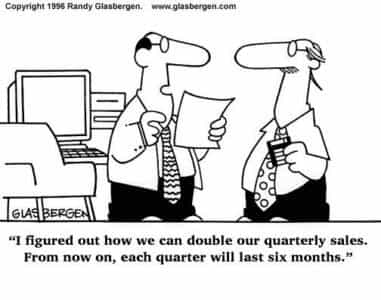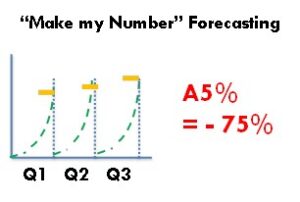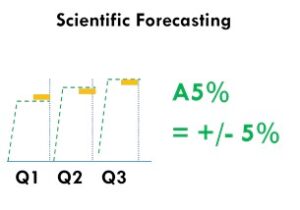Scientific Forecasting – 2 of 4: How to’s
This is blog no. 2 in our 4-blog series about Scientific Forecasting. In the last blog we talked about why managing expenses to the penny while winging the revenue forecasts doesn’t make financial sense and can cause wasted resources in excessive re-budgeting. In this second blog we’ll shift gears and start talking about how to implement Scientific Forecasting, beginning with a common problem: Overcoming psychological / cultural challenges to this more analytically rigorous way of managing a business.
- Overcoming common cultural challenges to scientific forecasting:
As more and more leads get generated from online behavior, which now can be tracked down to individuals’ browsing patterns, the amount of data that needs to be crunched to correctly attribute the origins of a pipeline is ever growing. And with it comes both, a greater burden on the analyst to be familiar with at least basic data collection and reduction techniques (e.g. multi-variate regression analysis, cohort analysis, basic probability theory, etc.; all available for study online), as well as a commitment to adapt and revise demand generation strategy based on what the data says.
Who hasn’t seen the classic battles raging over whether sales or marketing “sourced” a lead? As if that matters nowadays. It’s like trying to decide which shot won the basketball game. Did the prospect turn into a win because s/he read a white paper, came to the website, talked to an SDR, come to the booth, or followed the referral provided by a colleague? The answer is yes to all the above. The trick is to know which of these are the most efficient and success-prone channels, not who “sourced” them, so you know where to invest more and where less. To mitigate this issue, we now ask who “captured the lead”?
Which means there need to be forecasts across the entire pipeline – from customer success to marketing to sales. However, while marketing forecasts are in terms of leads, sales and customer success forecasts are in terms of $ pipeline or numbers of expected deals. For there to be a reliable model, there needs to be a good understanding of the analytics underlying a company’s lead lifecycle and specific pipeline conversion metrics.
Another, closely related issue is the need for management to support the conclusions of the data analysis, even if they head in a direction not aligned with prior thinking. A recent CEO we worked with was so convinced of the rectitude of his target market size instincts that any evidence to the contrary was being questioned to death, and the business analysts “punished” with oppressive data requests to justify their alternative conclusions. At some point his team just reported to him what he wanted to hear, and net new business pipeline generation continued to produce at 50% of the needed goal.
A variation on that theme can originate from the head of sales, where the implicit, old school message to the reps issuing their forecasts is that they better “make my number”, i.e. personally commit to a forecast. Vs. a more modern, analytics-driven approach to forecasting where they’re just reporting the state of their pipeline, say on a weekly basis, without pressure to generate a guaranteed outcome. Once SDRs and sales reps have begun to trust their management, they will report what’s in their pipelines so it can be made visible; and if need be, more pipeline generation initiatives can be launched. Vs. the old school approach where reps tend to wait with reporting what’s in their pipelines until a week or two before quarter end to not get shot over forecasted deals that didn’t pan out (see sidebar story below).
| At one mid-stage startup, after three quarters of forecasting sales using modern, analytics-enabled methods under the first sales management, a new head of sales came in whose instinct after years in a public company was to switch to the “make my number”, commitment-style of forecasting.
We can’t reproduce the actual InsightSquared reports for confidentiality reasons, but they essentially looked like this (the old management’s “scientific forecast” on the right, and the new leader’s “old school forecast” on the left):
The orange bars were the eventual closes for each quarter, and the green, dotted lines were the forecasts as they were calculated weekly as the quarter went on. The top forecast settled into a +/- 5% estimate of the eventual close after 5 weeks and stayed there. The old school forecast stayed at -75% five weeks into the quarter and didn’t stabilize until a few days before quarter end. |
-
- :
- In-quarter corrective actions:
Guess with which of the above approaches is there more predictability and more of an opportunity to counter-steer early in the quarter if pipeline generation is below goal? The modern, analytics-enabled approach also allows the forecaster to normalize between different sales reps’ innate forecasting tendencies; some are optimists prone to over-forecasting while others are more cautious and prefer to “sandbag” their numbers. In the end it all settles out into whatever the closed-won number is, but during the quarter as one tries to predict the outcome, compensating for reps’ own forecasting tendencies increases the overall forecasting accuracy.
Knowing how to compensate for forecasting biases and have a sense, say 4 or 5 weeks into the quarter how it will turn out, allows sales and marketing management to counter-steer (see sidebar story). Here are some practical, rapid response options for in-quarter corrections:
-
-
- Supporting sales pipeline building:
- “Air strikes” – Reps can call in “air strikes”, i.e. help from upper management to help close iffy deals; e.g. the head of products or the CEO personally call a prospect to address their concerns. This can improve the “likelihood to close” of unsure deals.
- “Local pipeline generation” – Marketing can utilize their demand generation infrastructure to drive leads to a local sales rep whose pipeline may be below goal. A call to action might be to attend a local event, and this allows driving in-territory brand awareness and introduce the local sales rep to prospects in his / her area.
- Supporting marketing pipe generation:
- Typically, this exercise for marketing revolves around which leads can be spooled up quickly? One example is “local pipeline generation” mentioned above. A challenge of in-quarter corrective action can be in terms of time: Some demand generation campaigns can take a few weeks to set up and be productive – so, unless there is visibility in the quarter, the in-quarter impact can be limited.
- Another approach involves digging into the various pipelines and see which ones have rapid pipeline velocity (i.e. move to the next higher stage quicker than others). We’ve found that SEM campaigns can spool up quickly, as can additional nurturing emails around an interesting piece of content or a local event that prospects may be interested in. Also, improving the conversion and click-through rates of high-trafficked website pages is a relatively quick way of generating leads.
- Supporting sales pipeline building:
-
Don’t turn that dial, we’ll be back with more …










